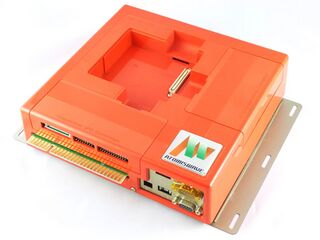Difference between revisions of "Atomiswave"
From Sega Retro
| Line 5: | Line 5: | ||
| name= | | name= | ||
| maker=[[Sammy]] | | maker=[[Sammy]] | ||
| − | | | + | | releases={{releasesArcade |
| − | | | + | | system_date_jp=2003-04{{fileref|Sammy AnnualReport 2003.pdf|page=13}} |
| − | | | + | | system_date_us=2004 |
| + | | system_date_uk=2004 | ||
}} | }} | ||
| − | The '''{{PAGENAME}}''' is an [[arcade]] | + | }} |
| + | The '''{{PAGENAME}}''', codenamed '''System X'''{{fileref|Sammy AnnualReport 2002.pdf|page=7}} is an [[arcade]] system created by [[Sammy]]. Based on the [[Sega Dreamcast]] console, it was designed as a low cost system for stand-alone locations such as pubs, bars and shopping centers{{fileref|Sammy AnnualReport 2003.pdf|page=13}}, as opposed to larger arcade chains typically associated with [[Sega]]. Originally slated for release in 2002{{fileref|Sammy AnnualReport 2003.pdf|page=24}}, the system went on sale in Japan in April 2003{{fileref|Sammy AnnualReport 2003.pdf|page=13}}, followed by a North American and European release in 2004. | ||
| + | |||
| + | Similar to Sega's Dreamcast-based [[NAOMI]] board, the Atomiswave uses removable game cartridges, as well as a removable module for changing the control scheme. While the hardware is similar to a retail Dreamcast, it has twice the VRAM and four times the audio RAM, though still has less memory (and is less powerful) than the NAOMI. However, the Atomiswave was sold for half the price of the NAOMI (and its closest competitors). Games can connect to the internet using either the standard 56k system or through "AW-Net". | ||
| + | |||
| + | Initially Sammy built and marketed the machine by itself, however following the 2004 merger with Sega, Sega took over the maintenance and sales of Atomiswave products. The last Atomiswave game officially produced was ''[[Sega Bass Fishing Challenge]]'' in 2009. | ||
==Games== | ==Games== | ||
Revision as of 04:50, 10 December 2020
This short article is in need of work. You can help Sega Retro by adding to it.

| |||||||||||||||||
| Atomiswave | |||||||||||||||||
|---|---|---|---|---|---|---|---|---|---|---|---|---|---|---|---|---|---|
| Manufacturer: Sammy | |||||||||||||||||
|
The Atomiswave, codenamed System X[2] is an arcade system created by Sammy. Based on the Sega Dreamcast console, it was designed as a low cost system for stand-alone locations such as pubs, bars and shopping centers[1], as opposed to larger arcade chains typically associated with Sega. Originally slated for release in 2002[3], the system went on sale in Japan in April 2003[1], followed by a North American and European release in 2004.
Similar to Sega's Dreamcast-based NAOMI board, the Atomiswave uses removable game cartridges, as well as a removable module for changing the control scheme. While the hardware is similar to a retail Dreamcast, it has twice the VRAM and four times the audio RAM, though still has less memory (and is less powerful) than the NAOMI. However, the Atomiswave was sold for half the price of the NAOMI (and its closest competitors). Games can connect to the internet using either the standard 56k system or through "AW-Net".
Initially Sammy built and marketed the machine by itself, however following the 2004 merger with Sega, Sega took over the maintenance and sales of Atomiswave products. The last Atomiswave game officially produced was Sega Bass Fishing Challenge in 2009.
Games
- Knights of Valour: The Seven Spirits (2003)
- Dolphin Blue (2003)
- Guilty Gear X Ver. 1.5 (2003)
- Demolish Fist (2003)
- Guilty Gear Isuka (2003)
- The King of Fighters Neowave (2004)
- The Rumble Fish (2004)
- Extreme Hunting (2005)
- The King of Fighters XI (2005)
- The Rumble Fish 2 (2005)
- NeoGeo Battle Coliseum (2005)
- Samurai Spirits Tenkaichi Kenkakuden (2005)
- Hokuto no Ken (2005)
- Extreme Hunting 2: Tournament Edition (2006)
- Metal Slug 6 (2006)
- Sega Clay Challenge (2008)
- Sega Bass Fishing Challenge (2009)
- Animal Basket (2005)
- Chase 1929 (possibly unreleased; last seen 2004)
- Dirty Pigskin Football (2004)
- Faster Than Speed (2004)
- Force Five (unreleased; last seen 2004)
- Horse Racing (2005)
- Kenju (unreleased; last seen 2004)
- Maximum Speed (2003)
- Premier Eleven (2003)
- Ranger Mission (2004)
- Netselect Salaryman Kintarou (2004)
- Sammy vs. Capcom (unreleased; last seen 2005)
- Sports Shooting USA (2003)
- Sushi Bar (2003)
References
| Sega arcade boards |
|---|
| Originating in arcades |
|
77
78
79
80
81
82
83
84
85
86
87
88
89
90
91
92
93
94
95
96
97
98
99
|
| Console-based hardware |
|
84
85
86
87
88
89
90
91
92
93
94
95
96
97
98
99
00
01
02
03
04
05
06
07
08
09
10
11
12
13
14
|
| PC-based hardware |
|
05
06
07
08
09
10
11
12
13
14
15
16
17
18
19
20
21
22
23
|